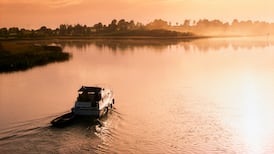A study of the fearsome, predatory pike – cherished by coarse fisherman; dreaded by brown trout anglers – has revealed a dramatic change in the balance of fish populations in Irish lakes and rivers over recent decades.
In research commissioned by Inland Fisheries Ireland (IFI), scientists examined the stomach contents of pike populations on Lough Conn, Co Mayo, and Lough Derravaragh, Co Westmeath, two of Ireland's most important lake systems.
Their findings, published on Wednesday following sampling in 2016, confirm roach now dominate their diet due an invasion of these waters by the smaller species. Previous research carried out in the 1960s and 1970s in the lakes indicated pike preferred to eat brown trout and perch.
Both brown trout and pike are of cultural significance in their own right, and support substantial recreational angling in Ireland. Their estimated annual combined economic contribution was valued at €253 million in 2014-2015.
The presence of pike in wild trout fisheries, however, is a source of tension between anglers, which regularly leads to calls that they should be culled in far greater numbers than at present. But the presence of roach in such large numbers may be the more significant threat, according to IFI. Roach are almost impossible to remove from a water system once established because of their presence in such high numbers.
The pike’s reputation stems from their torpedo-shaped body; shovel-like snout combined with a large mouth with many sharp teeth. They are piscivorous, meaning they are fish-eating, can grow to around 27kg in weight and live for up to 15 years.
Munster Blackwater
Roach were introduced to the Munster Blackwater river system in the 1890s and have spread elsewhere since but their numbers have accelerated since the 1980s.
The research also examined whether pike and brown trout can co-exist in the same habitat. Using advanced statistical models, it found that pike and brown trout could live together within relatively large deep lakes, however in small, low-complex systems pike could potentially have a devastating impact on resident brown trout populations, said IFI head of research and development Dr Cathal Gallagher.
The practice of pike removal and the impact it has on brown trout stocks was also examined.
“The findings suggest that pike removal may only be effective in protecting brown trout populations in systems where trout are the only available prey but may have little effect in systems where other prey, such as roach, is available,” he said.
The research was not conducted as part of “an agenda to extract pike”, said IFI chief executive Dr Ciarán Byrne. It was initiated “to answer some on-going questions relating to the dietary preference of pike and the pike-brown trout interactions in lakes across Ireland. Previous studies were carried out more than 50 years ago which is a long time within our changing lake systems”.
He added: “This research is important as it gives an insight into the behaviour of the pike species and provides updated information around their relationship with brown trout. The changing food web and altered preferences of predators in the water systems highlights the need for continued monitoring and updated data to inform effective management strategies.”
The study, “Pike (Esox lucius) in Ireland – Developing knowledge and tools to support policy and management”, would be circulated to all stakeholders including angler groups, he said.
Their views would be taken on board in determining “how best to adjust and mange our most important wild trout fisheries”, based on the best available scientific information.









